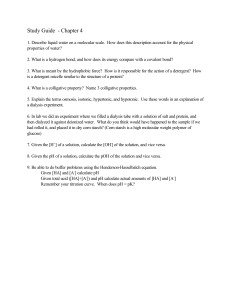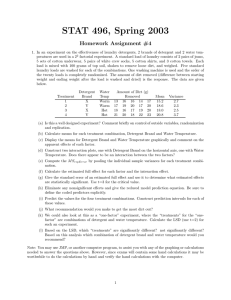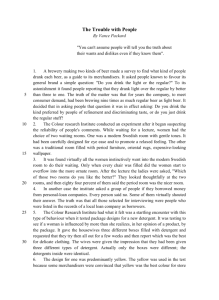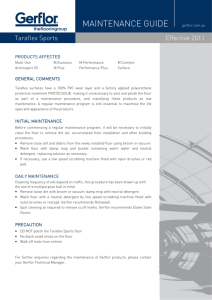PUBLIC WORKS TECHNICAL BULLETIN 420-49-28 2 NOVEMBER 1999 OIL/WATER SEPARATORS
advertisement
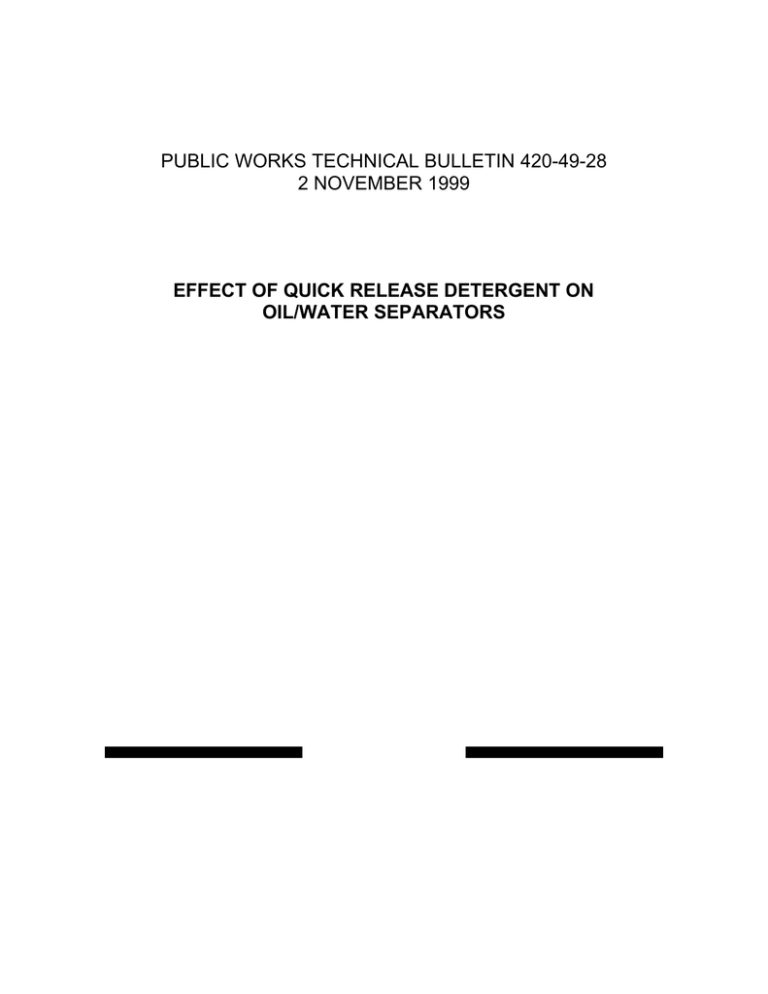
PUBLIC WORKS TECHNICAL BULLETIN 420-49-28 2 NOVEMBER 1999 EFFECT OF QUICK RELEASE DETERGENT ON OIL/WATER SEPARATORS Public Works Technical Bulletins are published by the U.S. Army Corps of Engineers, Installation Support Division, Alexandria, VA. They are intended to provide information on specific topics in areas of Facilities Engineering and Public Works. They are not intended to establish new DA policy. DEPARTMENT OF THE ARMY U.S. Army Corps of Engineers Installation Support Division 7701 Telegraph Road Alexandria, VA 22315-3862 Public Works Technical Bulletin No. 420-49-28 2 November 1999 FACILITIES ENGINEERING UTILITIES EFFECT OF QUICK RELEASE DETERGENT ON OIL/WATER SEPARATORS 1. Purpose. The purpose of this Public Works Technical Bulletin (PWTB) is to transmit recommendations regarding the use of a "quick release" detergent at Army motorpool washracks. This PWTB focuses on the effect that this type detergent has on the performance of oil/water separators. A "quick release" detergent causes an unstable oil-in-water emulsion to form. Being unstable, the emulsion quickly breaks and allows oil particles to separate from water in a relatively short period of time. 2. Applicability. This PWTB applies to all U.S. Army facilities engineering, public works, and environmental activities. 3. References. a. Army Regulation (AR) 420-49, "Utility Services," 28 April 1997. b. Technical Letter (TL) 1110-3-466, "Selection and Design of Oil/Water Separators at Army Facilities," 26 August 1994. c. AR 200-1, "Environmental Protection and Enhancement," 21 February 1997. 4. Discussion. a. AR 420-49, Section 4-8, contains policy for wastewater treatment and surveillance as it pertains to oil/water separators. TL 1110-3-466, Sections 1.2.4 and 1.2.5, discuss cleaning agents and methods. AR 200-1 contains general pollution prevention policies. b. Most detergents tend to cause stable emulsions of oil in water, thus rendering conventional oil/water separators useless. Emulsified oil will pass through simple gravity or coalescing type gravity separators. If oil is not removed in the separator, then (in most cases) it is discharged to the sanitary sewer. In locations where the separator discharges to a Publicly Owned Treatment Works (POTW), discharging emulsified oil may violate pretreatment discharge limits placed on that separator. The discharge of emulsified oil to a sewer system may also cause the treatment works to be in violation of an NPDES permit. Because of the potential for violations, use of detergents is prohibited at most Army ground vehicle washracks as a pollution prevention measure. c. In Army motorpools, vehicles and their components are washed to prepare them for inspection and for repair work. Even with hot water washers, the vehicles are only marginally clean. Soldiers often circumvent the ban on detergents in order to more effectively clean their tactical vehicles. d. Soap manufacturers are now marketing "quick release" detergents, which form unstable emulsions. These detergents are said to allow oil to separate from water in short periods of time. If the unstable emulsion breaks in a reasonable time, then oil/water separators could function properly. The detergent could be used without concern for regulatory violations. Manufacturers of washrack recycle treatment systems already provide "quick release" type cleaning agents to their customers, because they are said not to impact the treatment performance. Appendix A details a brief evaluation of a quick release detergent. The evaluation concluded that the detergent was indeed separator friendly and did not affect the separator performance. Appendix B is the Material Safety Data Sheet and fact sheet for the detergent that was tested. 5. Points of Contact. Questions and/or comments regarding this subject that cannot be resolved at the installation level should be directed to the U.S. Army Corps of Engineers, Installation Support Division, ATTN: CEMP-IS, 7701 Telegraph Road, Alexandria, VA 22315-3862, telephone (703)428-8233; Technical POC: U.S. Army Corps of Engineers, ATTN: CEMP-RI (Malcolm McLeod), 20 Massachusetts Avenue, NW, Washington, DC 20314, (202)761-0206, e-mail: malcolm.e.mcLeod@usace.army.mil; or the U.S. Army Engineer Research and Development Center, Construction Engineering Research Laboratory, ATTN: CEERD-CN-E (Gary Gerdes), P.O. Box 9005, Champaign, IL 61826-9005, telephone (800)USACERL, ext. 5430, FAX (217) 398-5564, or e-mail: ggerdes@cecer.army.mil. FOR THE DIRECTOR: FRANK J. SCHMID, P.E. Chief, Installation Support Policy Branch APPENDIX A EVALUATION OF BG-CLEAN 402’S EFFECT ON THE PERFORMANCE OF OIL/WATER SEPARATORS 1. Background a. Typically detergents used to wash vehicles have been incompatible with oil/water separators. These detergents form stable emulsions of oil in water that prevent the oil from floating to the surface in the gravity-type oil/water separators most commonly used at Army installations. The oil then passes through the separator and travels to the sewage treatment plant or other discharge point. This can create noncompliance with pretreatment or National Pollutant Discharge Elimination System (NPDES) requirements. Such emulsions will remain stable for long periods of time, unless some type of chemical treatment is used. The use of chemical treatment at Army motorpool washracks is not practical due to high operation and maintenance costs. Detergents are banned at almost all Army washracks because they cause oil to pass through oil/water separators. As an alternative, soldiers are encouraged to use hot water, high pressure washers. b. Hot water washers are now used in motorpools to clean vehicles prior to inspection, or to wash components prior to repair work. These washers work well in many applications, but when the surface to be cleaned is exceptionally greasy or oily, the level of cleanliness provided by the washers alone is not acceptable. Troops ignore the detergent ban to get the parts clean enough. They are willing to purchase unauthorized soap, either personally or with unit funds. A conflict has developed between the need to clean vehicles and the need to assure acceptable pretreatment of wash water. Water quality of separator discharges has a lower priority to soldiers because cleaning and maintaining tactical vehicles is linked to readiness, a very high priority. Therefore, it is necessary to find an acceptable method of washing that will not interfere with separator performance. c. Detergent manufacturers may have a solution. Many companies now make "quick release" or "separator friendly" detergents. These cleaning agents form unstable emulsions of oil and water. After a short time (10 minutes to 1 hour) the emulsion breaks. The oil then coalesces and rises to the water surface. The Construction Engineering Research Laboratory did a survey of most of the larger detergent manufacturers listed in the Thomas Register of American Manufacturers (Products and Services catalog) to identify those manufacturers that offered detergents considered to be "separator friendly." Limited funding prevented preliminary testing of several products in order to select one detergent to demonstrate. Thus, the vendor’s interest in our study and confidence in their products became the vendor selection criteria. BioCenter, Inc., the vendor for Biogenesis products, was particularly interested in our study and was willing to have one of their products demonstrated. After several discussions and exchanges of information regarding the Army’s needs and product capabilities, "BG-Clean 402 Bioremediating Industrial Cleaner" was selected for demonstration. The Material Safety Data Sheet for that cleaner is attached as Appendix B. It must be pointed out that selection of BG-Clean 402 in no way indicates the Government’s belief that other products would not have performed as well. 2. Laboratory Tests a. Before demonstrating the detergent at an Army installation motorpool, some laboratory testing verified the "quick release" characteristics. The simple tests involved mixing used oil with diluted detergent in a separatory funnel. The detergent was diluted according to the manufacturer’s recommendation. The two concentrations recommended for hot water washers were 1:20 dilution and 1:30 dilution. Two concentrations of oil were used: (1) 500 ppm, which is a typical concentration in wastewater discharged from Army washracks, and (2) 5000 ppm, which represents a peak concentration in wash water. After thorough mixing, the liquid was allowed to set for 1 hour, which is less than the typical detention time for an Army washrack oil/water separator. Tables 1 and 2 show the results of those tests. Table 1. 500 ppm oil. Total Organic Carbon Dilution 0 min 60 min 1:20 1260 40 1:30 268 -1321 1 Note that it is the nature of the TOC test procedure to sometimes produce negative numbers. It is acceptable in this case because qualitative results were more important than quantitative measurements. Table 2. 5000 ppm oil. Total Organic Carbon Dilution 0 min 60 min 1:20 1764 64 1:30 2396 392 b. Measurement of Total Organic Carbon (TOC) was used to determine the separation of oil from the water. This test was chosen over the oil and grease test for this portion of the study because it is less expensive to use, and generally more environmentally friendly because less solvent is required. While the measurement of TOC concentration cannot be directly converted to oil and grease concentration, the reduction of TOC is to a large extent generally proportional to reduction of oil and grease. The large reductions of TOC in the oil/detergent mixtures after 60 minutes clearly show that the oil did not remain in solution or in an emulsion. Further, oil was observed floating on the surface of the detergent mixture well before the 60-minute test was complete. The stated "quick release" characteristic of the detergent appears to be accurate. 3. Demonstration at an Army Motorpool a. Following the positive results of the laboratory testing, a demonstration was arranged at a motorpool at Fort Lewis, WA. The intent of the demonstration was to show that an oil/water separator would perform at approximately the same level of efficiency with or without the use of the "quick release" detergent. b. The motorpool chosen was occupied by the 542nd Maintenance Battalion, which is in Building 3966 at Fort Lewis. Building 3966 proved to be an excellent test site because of the variety of vehicle maintenance and maintenance cleaning activities that occur there. The battalion's mission involves maintenance activities for their vehicles and those vehicles belonging to other units. Washing vehicle parts and components is a critical step to any maintenance task, so washing is conducted more frequently at a maintenance battalion facility than at other motorpools. Washing can be done in all of the four large bays of Building 3966. Wash water flows to trench drains near the overhead doors, and then to a rectangular concrete, coalescing type, oil/water separator. Figure 1 shows typical washing being done at Building 3966. Figure 2 is a view looking down on the oil/water separator that serves the building. Figure 1. Typical washing at Building 3966, Fort Lewis. Figure 2. Oil/water separator at Building 3966, Fort Lewis. c. The performance of the separator was measured before initiating use of the detergent. Influent to and effluent from the separator were sampled during a washing exercise when several engines were cleaned. The samples were analyzed for oil and grease (O&G) and total suspended solids (TSS). The oil and grease test was used instead of TOC for this part of the study because O&G is normally the water quality parameter that is limited by regulation. For the purpose of demonstration, it is important to show quantitatively that O&G discharge limits (usually about 100 ppm for pretreatment) can be met. The results of this baseline testing are shown in Table 3. Table 3. Results of baseline testing of oil/water separator. O&G TSS Separator influent 105 ppm 391 ppm Separator effluent 12 ppm 10 ppm d. After baseline sampling was complete, the hot water, high-pressure washer that serves Building 3966 was set up to feed detergent into the wash water at about a 1:30 dilution. The controls of the washer allowed the soldiers using the spray wands to turn the detergent feed on or off as needed. e. The detergent was tested for 5 weeks and 4 days. During that period the soldiers used about 15 gallons of detergent. At the end of the test period, a second set of samples was taken to determine the performance of the separator with detergent in use. Table 4 shows the results of the analysis of those samples. Table 4. Results of testing of oil/water separator using detergent. O&G TSS Separator influent 396 ppm 1010 ppm Separator effluent 12 ppm 46 ppm f. Note that the concentrations of O&G and TSS were much higher in the separator influent during the second sampling than during the baseline sampling. Despite the increased contaminant loading and the presence of detergent, the performance of the separator was exceptionally good. It can be concluded that use of BG-Clean 402 is unlikely to affect the performance of an oil/water separator. The detergent seemed to improve the cleaning ability of the hot water washer significantly. However the effects of using the detergent over an extended period of time are not known. g. While the results of this limited test were certainly positive, a more extensive study is needed before this or any similar detergent can be recommended for unlimited use. Other test parameters regarding usage of "quick release" detergents should be evaluated. Those factors are: cleaning ability, toxicity to biological treatment systems, and corrosivity. An unqualified recommendation for full-scale use of this or any other "quick release" detergent cannot be made until a more extensive study is completed. However, in the interim, it is suggested that this detergent (or another neutral pH, proven "separator friendly" detergent) can be substituted for untested and unauthorized detergents that are currently being used at many locations. 4. Conclusion and Recommendation a. Testing of BG-Clean 402 indicates that it does not interfere with the performance of an oil/water separator when removing oil and settleable solids from wash water. b. Further testing of this and similar products should be completed before an unqualified recommendation for its use can be made. Consider interim use of this detergent (or equivalent) at locations where emulsifying detergents are currently being used. APPENDIX B MATERIAL SAFETY DATA SHEET FOR BG-CLEAN 402 This publication may be reproduced.

